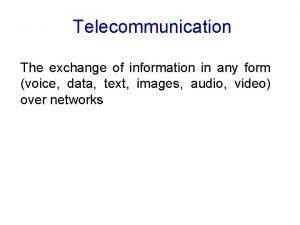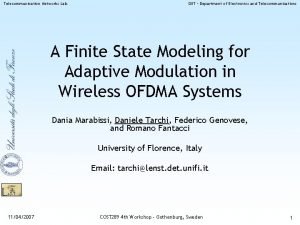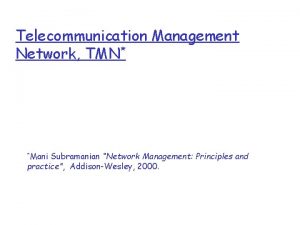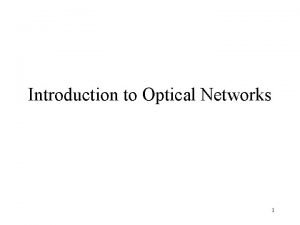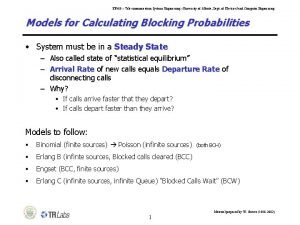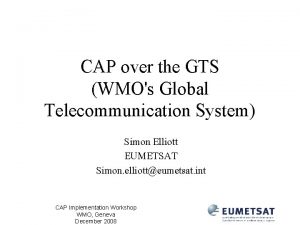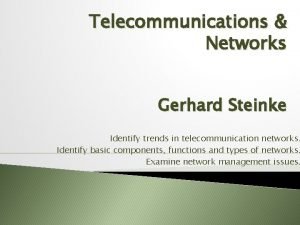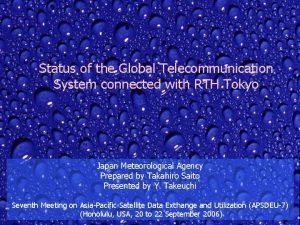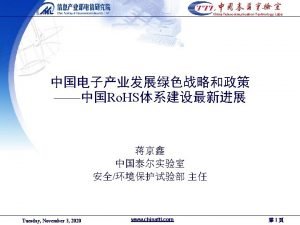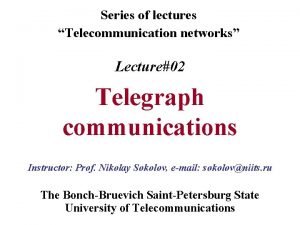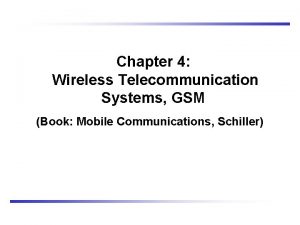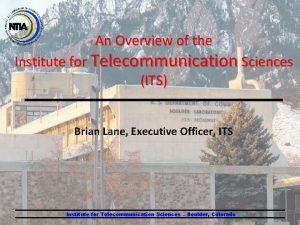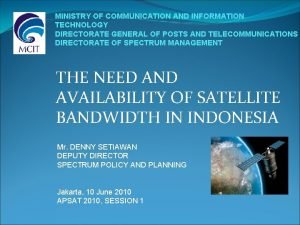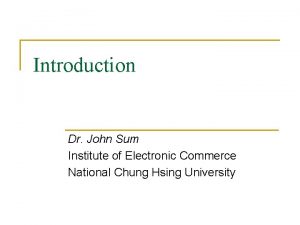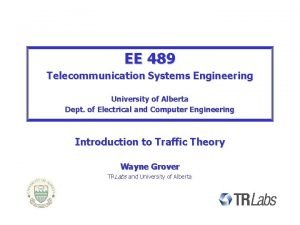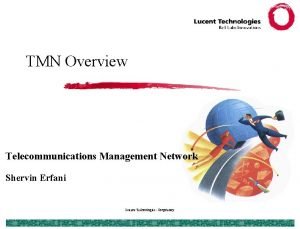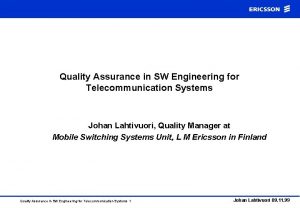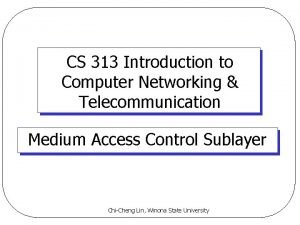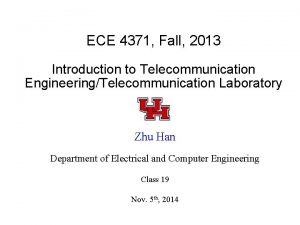ECE 4371 Fall 2017 Introduction to Telecommunication EngineeringTelecommunication













































- Slides: 45

ECE 4371, Fall, 2017 Introduction to Telecommunication Engineering/Telecommunication Laboratory Zhu Han Department of Electrical and Computer Engineering Class 3 Sep. 11 st, 2017

Overview l Homework – 4. 2. 1, 4. 2. 3, 4. 2. 5, 4. 2. 7, 4. 2. 9 – – – 4. 3. 3, 4. 3. 8 4. 4. 2, 4. 4. 4 4. 5. 2 4. 8. 1 Due 9/25/17 l FDM system, section 4. 7 Analog TV, section 4. 9 l Phase-locked loop, Section 4. 8 l FM basics 5. 1 -5. 3 l

Block diagram of FDM system.

FMA of SSB for Telephone Systems

Illustrating the modulation steps in an FDM system

AM Broadcasting l History l Frequency – Long wave: 153 -270 k. Hz – Medium wave: 520 -1, 710 k. Hz, AM radio – Short wave: 2, 300 -26, 100 k. Hz, long distance, SSB, VOA l Limitation – Susceptibility to atmospheric interference – Lower-fidelity sound, news and talk radio – Better at night, ionosphere.

Superheterodyne vs. homodyne l Move all frequencies of different channels to one medium freq. – In AM receivers, that frequency is 455 k. Hz, – for FM receivers, it is usually 10. 7 MHz. – Filter Design Concern – Accommodate more radio stations – Edwin Howard Armstrong

Television Digital Display (CRT) Analog Display (TV) Eliminate flicker effects

Deflection Signal and Synchronization Deflection signal and synchronization signal 525 30=8. 27 M

Solar Power and Human Eye

RGB, LIQ m. L=0. 3 mr+0. 59 mg+0. 11 mb m. I=0. 6 mr+0. 28 mg-0. 32 mb m. Q=0. 21 mr-0. 52 mg+0. 31 mb

Bandwidth VSB and QAM

Comb Filtering

NTSC, PAL, and SECAM l National Television System Committee – Low complexity, higher vertical color resolution – 525 line/60 Hz(30 frames per second) l Phase Alternative Line: PAL – The phase of the color components is reversed from line to line – Robust to Multipath, phase distortion – 625 line/50 Hz(25 frames per second), slightly larger bandwidth l SECAM – Requires the receiver to memorize the content of each line l Mono when used for different standards

TV standards in the world

Carrier Recover Error l DSB: e(t)=2 m(t)cos(wct)cos((wc+ w)t+ ) e(t)=m(t) cos(( w)t+ ) – Phase error: if fixed, attenuation. If not, shortwave radio – Frequency error: catastrophic beating effect l SSB, only frequency changes, f<30 Hz. – Donald Duck Effect l Crystal oscillator, atoms oscillator, GPS, … l Pilot: a signal, usually a single frequency, transmitted over a communications system for supervisory, control, equalization, continuity, synchronization, or reference purposes.

Phase-Locked Loop l Can be a whole course. The most important part of receiver. l Definition: a closed-loop feedback control system that generates and outputs a signal in relation to the frequency and phase of an input ("reference") signal l A phase-locked loop circuit responds both to the frequency and phase of the input signals, automatically raising or lowering the frequency of a controlled oscillator until it is matched to the reference in both frequency and phase.

Voltage Controlled Oscillator (VCO) l W(t)=wc+ce 0(t), where wc is the free-running frequency l Example

Ideal Model Si Sp Sv LPF So VCO – Si=Acos(wct+ 1(t)), Sv=Avcos(wct+ c(t)) – Sp=0. 5 AAv[sin(2 wct+ 1+ c)+sin( 1 - c)] – So=0. 5 AAvsin( 1 - c)=AAv( 1 - c) l Capture Range and Lock Range

Phase and Frequency Acquisition

Carrier Acquisition in DSB-SC l Signal Squaring method l Costas Loop l SSB-SC not working

PLL Applications l Clock recovery: no pilot l Deskewing: circuit design l Clock generation: Direct Digital Synthesis l Spread spectrum: l Jitter Noise Reduction l Clock distribution

FM Basics l VHF (30 M-300 M) high-fidelity broadcast l Wideband FM, (FM TV), narrow band FM (two-way radio) l 1933 FM and angle modulation proposed by Armstrong, but success by 1949. l Digital: Frequency Shift Key (FSK), Phase Shift Key (BPSK, QPSK, 8 PSK, …) l AM/FM: Transverse wave/Longitudinal wave

Angle Modulation vs. AM l Summarize: properties of amplitude modulation – Amplitude modulation is linear u just move to new frequency band, spectrum shape does not change. No new frequencies generated. – Spectrum: S(f) is a translated version of M(f) – Bandwidth ≤ 2 W l Properties of angle modulation – They are nonlinear u spectrum shape does change, new frequencies generated. – S(f) is not just a translated version of M(f) – Bandwidth is usually much larger than 2 W

Angle Modulation Pro/Con Application l Why need angle modulation? – Better noise reduction – Improved system fidelity l Disadvantages – Low bandwidth efficiency – Complex implementations l Applications – – – FM radio broadcast TV sound signal Two-way mobile radio Cellular radio Microwave and satellite communications

Instantaneous Frequency • Angle modulation has two forms - Frequency modulation (FM): message is represented as the variation of the instantaneous frequency of a carrier - Phase modulation (PM): message is represented as the variation of the instantaneous phase of a carrier

Phase Modulation l PM (phase modulation) signal

Frequency Modulation l FM (frequency modulation) signal (Assume zero initial phase)

FM Characteristics l Characteristics of FM signals – Zero-crossings are not regular – Envelope is constant – FM and PM signals are similar

Relations between FM and PM

FM/PM Example (Time/Frequency)

Frequency Modulation l FM (frequency modulation) signal (Assume zero initial phase)

Example Consider m(t)- a square wave- as shown. The FM wave for this m(t) is shown below. m(t) 0 T 2 T

Frequency Deviation l Frequency deviation Δf – difference between the maximum instantaneous and carrier frequency – Definition: – Relationship with instantaneous frequency – Question: Is bandwidth of s(t) just 2Δf? No, instantaneous frequency is not equivalent to spectrum frequency (with non-zero power)! S(t) has ∞ spectrum frequency (with non-zero power).

Modulation Index l Indicate by how much the modulated variable (instantaneous frequency) varies around its unmodulated level (message frequency) A l Bandwidth

Narrow Band Angle Modulation Definition Equation Comparison with AM Only phase difference of Pi/2 Frequency: similar Time: AM: frequency constant FM: amplitude constant Conclusion: NBFM signal is similar to AM signal NBFM has also bandwidth 2 W. (twice message signal bandwidth)

Example

Block diagram of a method for generating a narrowband FM signal.

A phasor comparison of narrowband FM and AM waves for sinusoidal modulation. (a) Narrowband FM wave. (b) AM wave.

Wide Band FM l Wideband FM signal l Fourier series representation

Example

Bessel Function of First Kind

Spectrum of WBFM (Chapter 5. 2) l Spectrum when m(t) is single-tone l Example 2. 2

Bandwidth of FM l Facts – FM has side frequencies extending to infinite frequency theoretically infinite bandwidth – But side frequencies become negligibly small beyond a point practically finite bandwidth – FM signal bandwidth equals the required transmission (channel) bandwidth l Bandwidth of FM signal is approximately by – Carson’s Rule (which gives lower-bound)

Carson’s Rule l Nearly all power lies within a bandwidth of – For single-tone message signal with frequency fm – For general message signal m(t) with bandwidth (or highest frequency) W
 What is telecommunication network
What is telecommunication network Njdv
Njdv Risk management in telecommunication projects
Risk management in telecommunication projects Objectives of telecommunication
Objectives of telecommunication Types of telecommunication networks
Types of telecommunication networks Means communication at a distance
Means communication at a distance Kyushu telecommunication network co.,inc.
Kyushu telecommunication network co.,inc. Telecommunication
Telecommunication Tmn conceptual model
Tmn conceptual model Society of worldwide interbank financial telecommunication
Society of worldwide interbank financial telecommunication Telecommunications network architecture
Telecommunications network architecture Telecommunication
Telecommunication Global telecommunication system
Global telecommunication system Gerhard steinke
Gerhard steinke Global telecommunication system
Global telecommunication system Itu world telecommunication indicators database
Itu world telecommunication indicators database Jaringan wireline
Jaringan wireline China telecommunication technology labs
China telecommunication technology labs Telecommunication
Telecommunication Telecommunication sealing technology
Telecommunication sealing technology Bsc and msc in telecom
Bsc and msc in telecom Institute for telecommunication sciences
Institute for telecommunication sciences World telecommunication standardization assembly
World telecommunication standardization assembly Ministry of telecommunication
Ministry of telecommunication Rrpdata
Rrpdata Telecommunication
Telecommunication Cablaggio strutturato edifici
Cablaggio strutturato edifici Telecommunication
Telecommunication Telecommunication management network
Telecommunication management network Umos msu
Umos msu Telecommunication system architecture with diagram
Telecommunication system architecture with diagram Quality control in telecommunication
Quality control in telecommunication Telecommunication sealing technology
Telecommunication sealing technology Telecommunications for dummies
Telecommunications for dummies Telecommunication medium
Telecommunication medium China telecommunication technology labs
China telecommunication technology labs Network management principles
Network management principles Telecommunication system architecture with diagram
Telecommunication system architecture with diagram Essay structure introduction
Essay structure introduction Vcaa english exam 2017
Vcaa english exam 2017 Mon tue wed thur fri sat sun
Mon tue wed thur fri sat sun Astro quiz 2019 questions and answers round 2
Astro quiz 2019 questions and answers round 2 Astro quiz 2016 questions and answers
Astro quiz 2016 questions and answers Saasta astro quiz 2018 questions and answers
Saasta astro quiz 2018 questions and answers Rsa identity management and governance l1
Rsa identity management and governance l1 Kpi 2017
Kpi 2017




